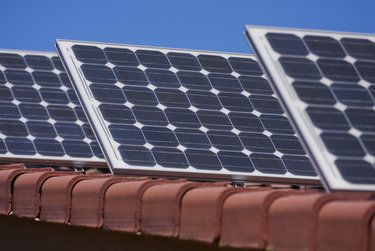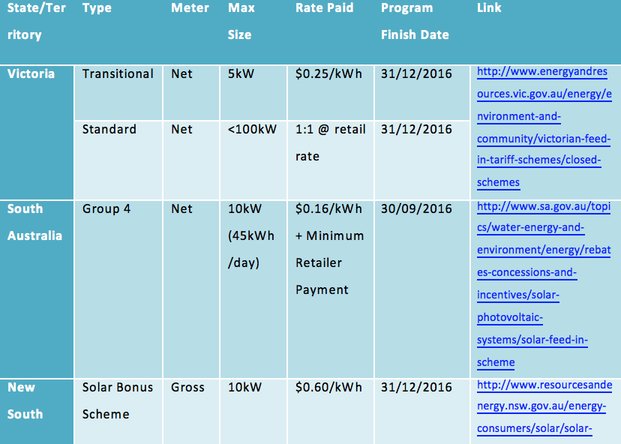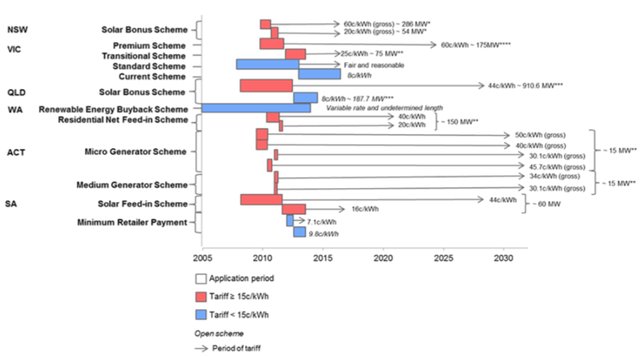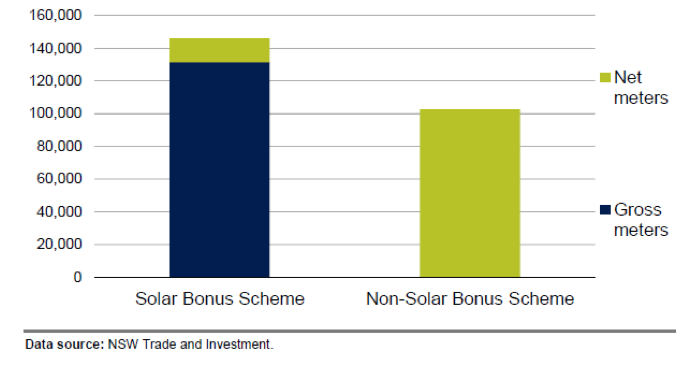 This time next year, Victoria, South Australia and New South Wales will terminate a number of their rooftop solar feed-in tariff programs, putting to an end the premium tariffs in these three states. For the households currently on these premium tariffs, now is a good time to start thinking about what this means, and what they should do. First, a look at the tariffs that will be scrapped – and when:
Even more importantly, South Australia and Victoria have opted for net metering policies, which means that, when the feed-in tariff programs end, no metering changes are necessary. In these cases, the net meter can continue to operate as normal and customers can negotiate with their retailers to sell back exported energy at an agreed rate. This time next year, Victoria, South Australia and New South Wales will terminate a number of their rooftop solar feed-in tariff programs, putting to an end the premium tariffs in these three states. For the households currently on these premium tariffs, now is a good time to start thinking about what this means, and what they should do. First, a look at the tariffs that will be scrapped – and when:
Even more importantly, South Australia and Victoria have opted for net metering policies, which means that, when the feed-in tariff programs end, no metering changes are necessary. In these cases, the net meter can continue to operate as normal and customers can negotiate with their retailers to sell back exported energy at an agreed rate. IPART – Final Report – Solar feed-in tariffs – The subsidy-free value of electricity from small-scale solar PV units from 1 July 2014
GSES spoke to the NSW Department of Trade and Investment (NSW T&I) in order to understand how they plan to assist these customers in making the transition to net metering as simply as possible, and hopefully without any financial loss. The following is the question and answer session conducted with NSW T&I: The NSW Solar Bonus Scheme (SBS) is coming to an end on 31/12/2016. How does NSW Department of Trade and Investment plan on communicating with the ~146,000 customers who currently partake in this scheme? “Further information on planning for an orderly end to the Scheme will follow tabling of the Statutory Report into the Scheme’s operation by the Minister for Resources and Energy. At this stage it is likely that the Department will contact the ‘20 c/kWh’ customers first: the majority of these customers have gross meters. They will then be better off with a net meter. Wherever the retail usage charge exceeds the feed-in tariff, a customer is better off with a net meter. This is because the customer may consume their generator’s energy instead of being forced to export it for a feed-in tariff (as happens with a gross meter) that is lower than the usage charge. The situation for the ‘60 c/kWh’ customers is more complex. They are unlikely to want to change their meter until the end of the Scheme.” Who is responsible for bearing the meter change cost and are you able to indicate how much a customer should be prepared to spend for such a service? “Customers may contact Level 2 accredited service providers (ASPs) to get a quote for meter change services. Meter change is a contestable service. The list of L2 ASPs can be found on the Resources & Energy website. There are two components to the meter change cost: the meter itself and the labour for meter replacement. Until now DNSPs have supplied the meter to the Level 2 Accredited Service Provider (meter installer) for no charge and then ‘smeared’ the cost of meter provision across all customers. The AEMC push has been to make network charges more ‘cost reflective’ of the impacts that customers have on networks. There has been extended consultation and the AER’s recent determination for the NSW DNSPs means meter provision will become a contestable service. I think the DNSPs commence charging customers for the meter from 1 July, but customers may find their retailer is willing to make an energy offer that includes installation of an advanced (smart) meter.” Is there any way a customer might be able to avoid bearing this cost, for example, with a digital or smart meter upgrade from the retailer/DNSP? And if so, what other factors might the customer have to consider, perhaps such as time of use metering? “The costs of network services are always borne by customers whether smeared or individually. If retailers make energy offers that include a meter change then the customer may find there is no installation charge per se. This is analogous to mobile phone offers where the costs of handsets are recovered through phone or data/service plans.” How does NSW Department of Trade and Investment plan to transition customers from gross to net meters and how are customers able to avoid meter change delays after the scheme end date? “Any customer may change to a net meter at any time. The NSW government will not force customers to change but will endeavour inform customers of their options. 20 c/kWh customers may wish to consider this now. However, they may wish to contact their retailer or competing retailers to determine whether they have plans to supply an advanced meter. Some meter providers have meters that can be remotely reconfigured from gross to net. This would be attractive for customers who are on the 60 c/kWh rate as the switch over from gross to net billing would no longer be connected to the installation date. It is up to those metering providers to convince retailers to use their meters/service. For retailers that may be an attractive option for customer retention/acquisition.” Does NSW Department of Trade and Investment plan to specify metering requirements, as this could be an opportunity to move customers to smart-interval meters as Victoria has done. “No. No jurisdiction wishes to repeat the Victorian method of meter change. The NSW Government’s policy on advanced metering is that customers will not be compelled to install a smart meter. Customers may opt out. However, once an advanced meter is installed on a premises there will be no reversion. It is important to distinguish between smart meters and the ‘smart energy services’ that they facilitate.” Is NSW Department of Trade and Investment working with any other state bodies to share knowledge about this transition? “NSW T&I has had preliminary discussions with the DNSPs and will consult with retailers, meter providers, and customer advocates. Some industry participants and observers perceive the end of the Scheme will trigger a huge number of inquiries about everything from storage to upsizing generating capacity. However, the size of Scheme generators is small by today’s standards. The department’s communications will provide guidance to help customers to make informed choices.” In summary, the responsibility of meter changes for those customers whose gross FiTs are soon to expire will fall on the customers themselves. NSW T&I is likely to start contacting those customers affected some time in 2016, however solar customers will then be responsible for contacting a level 2 accredited service provider in order to change their system to net metering. Although the responsibility and costs for this ultimately lies with the customer, it is possible that offerings will be made from energy retailers that bundle these costs in energy contracts. As the storage market increases, it is also likely that any bundled offering from retailers will include the installation of battery storage systems. We are already seeing the beginnings of this from the large ‘gentailers’. The NSW T&I rightfully seem cautious about forecasting the end of the SBS as a boon for the energy storage industry. However, considering that most of these customers entered the market with a clear understanding of the benefits of the program, it can be assumed that they understand what they will be losing. It is also these customers who are the early adopters of new technology and will likely be the ones most interested in energy storage. Given that customers will have to engage an ASP2, either directly or through a retailer, this would be an excellent opportunity for them to increase the utilisation of their solar system and install storage. The renewables industry is, by its nature a disruptive industry. The opportunity certainly exists for a forward thinking retailer to create a packaged energy services solution to target this segment with metering upgrades, storage, and possibly an increase in their solar capacity. It is entirely possible that the end of 2016 will signal the beginning of the energy storage market boom in Australia. This article was sourced from One Step Off The Grid. You can read the original article here.
0 Comments
Leave a Reply. |
|




 RSS Feed
RSS Feed


